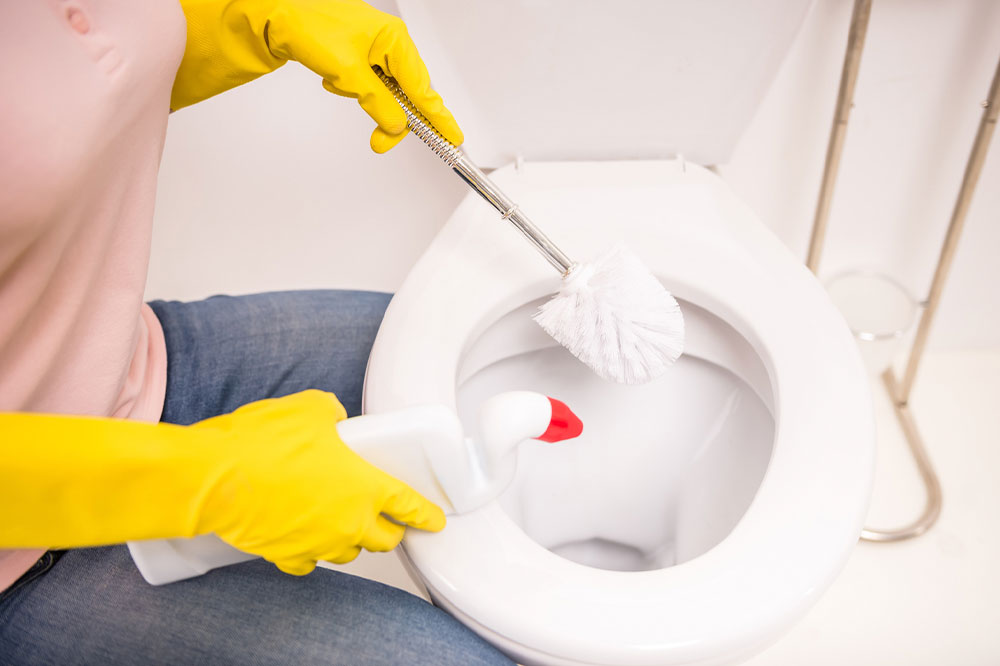Top 7 toilet cleaning mistakes to avoid

It doesn’t matter how often you do it; cleaning the toilet and washroom areas will remain unpleasant. This task is your responsibility unless you can afford to hire professional cleaning services that charge hundreds of dollars. But you can do a few things better than your last time cleaning the toilet to save time and effort. All you need to do is avoid the following mistakes while cleaning and scrubbing your toilet:
Failing to remove any clutter
It is important to move things around before you start cleaning anywhere. Start by clearing out loose bins for collecting the dirty laundry, tackling the cabinets filled with toiletries, and removing any other accessories that you keep inside the washroom. It’s only possible to ensure thorough cleanliness when there is space to move around and reach inaccessible places due to the clutter. This is also an excellent time to check for used and expired products and declutter the cabinets. Decluttering itself is a major cleaning task that will save you a lot of hassle. Simply restock the necessities once the cleaning is done.
Failing to make a plan
You need to outline each task and evaluate the best way to execute it without creating additional side tasks. Once you’ve cleared out the space, step back and evaluate the most easily accessible areas inside the bathroom. Start by scrubbing the wall tiles, sinks, and cabinet areas away from the toilet bowl. This way, when you finally tackle that dirty task, nearly two-thirds of the space has already been cleaned. You can now go ahead and disinfect the toilet bowl, scrub the seats, and tackle all other accessories installed in and around it. You also save a lot of time by planning the cleaning in advance.
Mixing cleaning products
Never make the mistake of mixing cleaning products without first understanding what’s inside. Commercial-grade disinfectants, sanitizers, and solutions are mixed with several chemicals. Mixing one product with another can release fumes that may not even be completely visible. Inhaling these toxic fumes can make you sick. So always check to see if using a particular disinfectant with another surface cleaner is safe. For example, something as simple as bleach and ammonia, common cleaning products, release deadly gases when combined in the smallest quantities. The same goes for DIY cleaning remedies like vinegar and bleach. Read the labels carefully and check the information on known chemical reactions mentioned on the product labels before using them.
Using abrasives on delicate surfaces
The toilet bowl, seat, tiles on the wall, bathtubs, and floor tiles are usually made of ceramic materials sensitive to certain cleaning products. Using a commercial-grade abrasive cleaner can rob the shine off these surfaces and cause the ceramic to chip away due to a severe reaction. This also goes for metallic surfaces made with stainless steel for the taps, showerheads, and other accessories installed around the bathroom. Repeated exposure to certain cleaning products can cause pitting over the surface triggered by the abrasive materials. Use only mild cleansing soap and water for delicate surfaces. You can also buy ceramic-friendly cleaners that come in liquid form with easy applicators and nozzles.
Cleaning in a hurry
Cleaning takes time, depending on the size of the bathroom and the accessories installed. The more places you have to clean, the more time it will take since you can only do one task at a time. It is impossible to dust and wipe down simultaneously, as the dust will simply settle in a different area. If there are limescale and mold deposits, more time is needed to spray these areas with a solution that breaks up the grime. Only then is it possible to properly wipe everything. Rushing the job will only make you repeat the task to get the desired results.
Skimping on the tools
Not everything can be cleaned with just a plain cloth. You’ll have to purchase decent cleaning accessories and use these products properly. Buy a toilet brush, a mop, a scrub brush, colored sponges, a microfiber cloth, and some rubber gloves, for starters. Equip yourself with the right tools and tackle each individual task using the right accessories to achieve effective results. Also, most of these tools and accessories are built to last only for a limited number of uses. Replace them as soon as you notice wear and degradation. Remember, investing in a few good accessories and tools will save you hundreds of dollars by avoiding calling a professional cleaning service. Regular cleaning is just as sufficient when compared to a one-time job.
Failing to clean up after everything
Always switch on the exhaust fan after a thorough cleaning. Notice how the bathroom becomes foggy and dingy due to the extra moisture released when surfaces react with the cleaning products? You need to switch on the fan to air out these fumes. For larger bathrooms, it’s also a good idea to open the windows to increase cross-ventilation and speed up the process. What’s even more critical is handling all the tools and cleaning products used. Don’t just throw everything into one bin! Place the cleaning products in the cabinets after securing the lids. Wipe down the accessories you’ve used and let the mops, scrubs, and brushes dry out. These tools harbor all the bacteria and gunk. So, you must dispose of the one-time-use products properly and clean the rest of the accessories before wrapping them up in the washroom.
Note that if it has indeed been a while since the last time the washroom was thoroughly cleaned, you can consider hiring help to get started. Some tasks are beyond your control and may require expert intervention.


